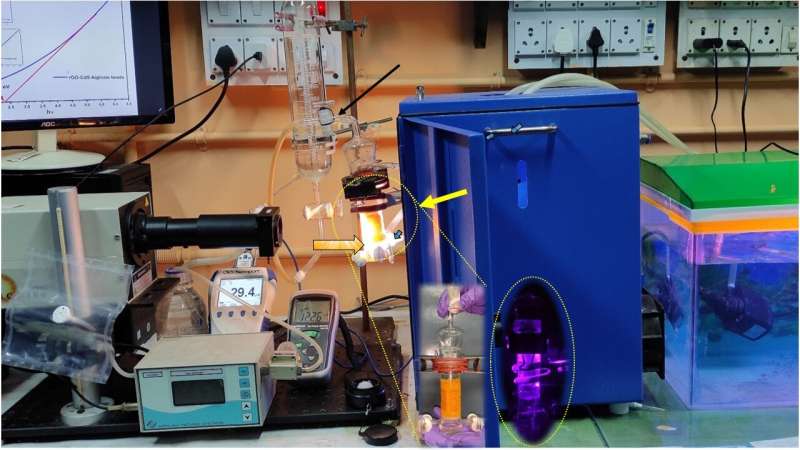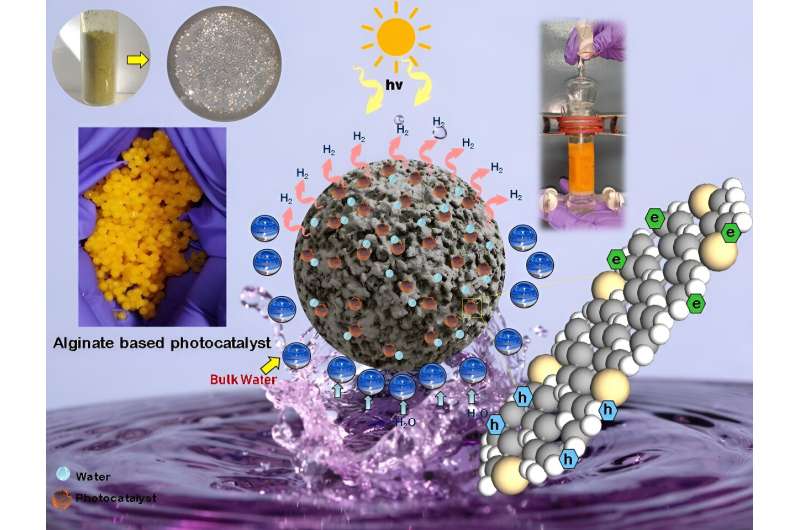January 15, 2024 dialog
This article has been reviewed according to Science X's editorial process and policies. Editors have highlighted the following attributes while ensuring the content's credibility:
fact-checked
peer-reviewed publication
trusted source
written by researcher(s)
proofread
Food-grade encapsulated photocatalyst materials for clean, green hydrogen generation

Environmental pollution and affordable clean energy are the two major sustainable development goals set by the United Nations General Assembly in 2015. All countries set their goals for decarbonization by the year 2050 and increasing the use of green hydrogen to reduce the load of electricity consumption per year.
Industries and research groups jointly collaborated to increase the production of green hydrogen and lower the production cost. In 2023, we noticed the global energy crises in major parts of Europe during the war, leading to high prices and shortage of liquefied natural gas and the worsening of climate change.
Commonly, green hydrogen is generated via electrolyzers and photocatalytic water splitting. There are some barriers to the commercialized production of green hydrogen, such as high production costs, photocatalyst stability, catalyst performance and seawater use.
Photocatalytic solar water splitting has opened a new window of opportunity for the production of low-cost green hydrogen in accordance with environmental protection. Solar light is abundant in the environment and choosing the correct high-performance, long-term, stable photocatalyst may enhance production and lower the price of green hydrogen.
Notably, all the photocatalysts available for hydrogen production by water splitting are in the form of powdered nanoparticles, causing metal loss and aggression, resulting in lower photocatalytic activity and an impact on the operating cost. Also, powdered nanoparticle photocatalyst systems only operate in batch mode and are unable to control the hydrogen production rate.

The powdered nanoparticle photocatalyst contains semiconductors that can leach out into water bodies and harm the ecological pyramid. Metal-organic frameworks have been proposed to support the alloy's nanoparticles in order to prevent metal aggregation during the reaction and to boost catalytic activity.
The team under Prof. Kajari Kargupta of the nanoengineering and sustainable energy lab, Chemical Engineering Department, Jadavpur University, India, has now developed an environmentally friendly, recyclable 3D organic alginate hydrogel encapsulated in a bead-type photocatalyst. The study is published in the International Journal of Hydrogen Energy.
These types of 3D metal-organic framework-based hydrogel photocatalysts can provide a steady rate of continuous hydrogen. The toxic effect of the semiconductor is minimized through encapsulation with the food-grade material sodium alginate.
Sodium alginate is the preferred biopolymer for the photocatalyst-encapsulated millispheres. It is commercially manufactured from brown seaweed extract. Over time, several research groups have formed diverse metal-polymer composites due to the immobilization of the metal ions during the gelation process.
A pressure-driven flow-through system operating in both batch and continuous modes under full-band solar irradiation was investigated for enhanced solar hydrogen production from water using a novel 3D millisphere of organic alginates hydrogel-encapsulated photocatalyst with high water retention capability. The prime focus was projected on the role of the enhancement of adsorption of the water molecule on the active sites of the photocatalyst on the performance of solar hydrogen production.
From a functional perspective, the addition of sodium alginate increases the photocatalyst's activity and water retention capacity, enabling the process of continuous hydrogen generation. From an operational perspective, alginate's presence boosts the photocatalyst's activity and water retention capacity, enabling the process of constantly generating hydrogen.
Every spherical bead-shaped alginate-encapsulated photocatalyst functions as a miniature hydrogen producer or photocatalytic reactor. The alginate hydrogels also showed outstanding recyclability and reuse. Their synthetic repeatability and linear scalability are confirmed by the fact that the total amount of hydrogen generated rises linearly with the number of photocatalyst-encapsulated beads while the volume-normalized rate remains constant.
The degree of hydration—both pre- and dynamic water adsorption—strongly influences the rate at which hydrogen is produced. A flow reactor is used to produce hydrogen at a constant rate; when the incoming flow rate falls below a critical value, the production rate remains constant, indicating that each spherical catalyst functions as a small hydrogen generator.
Prof. Kargupta is experienced in transforming lab-scale prototypes into practical commercial applications, and our multi-disciplinary team contains expertise in solar hydrogen generation, fuel cell electrolyte membrane/electrode fabrication, and carbon sequestration. The team is trying to scale up the capacity of the generated hydrogen for powering the portable fuel cells in remote areas.
The main chemical used for the encapsulation of the photocatalyst is sodium alginate, which is considered a food-grade material (emulsifier, stabilizer, thickener, and gelling agent) by the U.S. Food and Drug Administration and the European Commission. The alginate hydrogel-based photocatalyst with a suitable photoreactor will be assembled with high storage and fuel cells in the next two years. We plan to collaborate with industry partners to scale up this high-performance photocatalyst on an industrial scale.
This story is part of Science X Dialog, where researchers can report findings from their published research articles. Visit this page for information about ScienceX Dialog and how to participate.
More information: Sayantanu Mandal et al, Organic alginate encapsulated rGO-CdS millispheres for remarkable photocatalytic solar hydrogen production, International Journal of Hydrogen Energy (2023). DOI: 10.1016/j.ijhydene.2023.09.137
Prof. Kajari Kargupta, Chemical Engineering Department, Jadavpur University received her Ph.D. on "Instability and pattern formation in thin films: role of heterogeneity, evaporation and slippage" in 1998 from I.I.T. Kanpur. She has expertise on thin film system, pattern generation, formation of nanostructures of different morphologies and their application. She has successfully completed several projects sponsored by SERB DST, UGC, DBT and DRDO and has more than 100 peer-reviewed journal publications to her credit. She has experience in formulation of graphene-based bimetallic nano-hybrid materials of different morphologies and their application as catalysts, electrocatalyst for hydrogen generation. As a part of an earlier DST sponsored project, she explored the synthesis and characterization of graphene-based bimetallic nano-hybrid catalysts for hydrogen generation from sodium borohydride and borohydride electro-oxidation; based on composition-morphology-performance mapping a novel rGO based–connected core shell G-Co-Pt nano-hybrid catalysts that exhibits excellent electron transport property has been explored for hydrogen generation as well as an ORR catalyst to reduce the Pt loading. Dr. Kargupta has experience in synthesis and characterization of electrocatalysts for electro-oxidation, oxygen reduction reaction and fuel cell application. She has explored photocatalytic and photo electrocatalytic solar hydrogen generation through water splitting; the goal of which is to address the major process bottlenecks and enhance the solar to hydrogen efficiency. Based on experimental as well quantum simulation the role of nano-hybrid catalysts/ photo-catalyst and photo-electro catalysts are analyzed and explored. Earlier as a part of UGC major project Prof. Kargupta explored different inorganic–organic nanocomposite membrane electrolytes as well as gel type portable, durable and proton conductive electrolytes especially for the portable application of fuel cell. Prof. Kargupta has experience handling 10 sponsored projects as PI and Co-PI. She has also worked with NMRL, DRDO on a mission project related to fuel cell application as research service provider.
Mr. Sayantanu Mandal is currently completing his Ph.D. in the Dept of Chemical Engineering, Jadavpur University, under the supervision of Prof. Kajari Kargupta. For the last three years he is been engaged in working on hydrogen generation and the fabrication of a high-temperature fuel cell electrolytic membrane. Currently he is also a PI of a project under Indian Science Technology Engineering facilities map under Govt of India (I-STEM) with his guide Prof Kajari Kargupta (I-STEM/Catalyticgrant/acad_24/2022-23). He is also a permanent member of some of the prestigious scientific global organizations such as the International Association of Engineers (IAENG) and International Academy of Science and Engineering for Development (IASED), Hongkong. Also he is also in the technical committee of Technical Committee of MEAMT 2023, NanoMT 2023 and ICFMCE 2023 as a peer-reviewer.
Journal information: International Journal of Hydrogen Energy





















